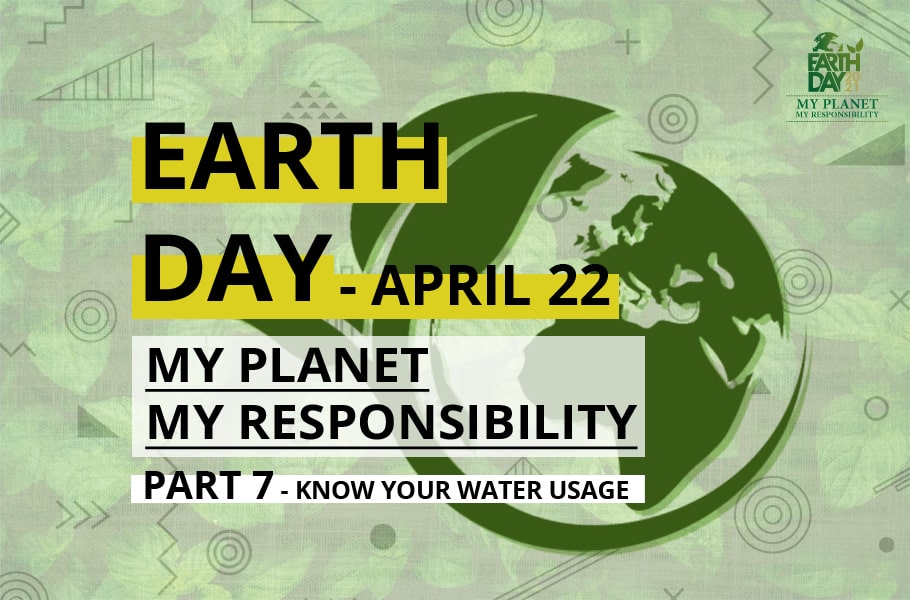
Want to save water? Know your water footprint first
We don’t just drink water, but we eat water as well. A closer look at the concept of water footprint will explain that we don’t just drink and eat water, but we wear it, play with it, drive it and what not!

We don’t just drink water, but we eat water as well. A closer look at the concept of water footprint will explain that we don’t just drink and eat water, but we wear it, play with it, drive it and what not!
How much water do you use?
A survey of citizens done in the city of Pune some years back revealed that people believe they use about 70 litres of water every day. They considered their drinking water needs, washing, bathing, cooking needs etc to reach the conclusion. This is just about 5% of the total water they use every day. What they did not consider was the invisible water use like food needed to grow rice, wheat, pulses, oilseeds etc. The products that we buy from market like TV, mobile, clothes, car, house etc also need water for manufacture. Per person per day water usage can be calculated only after we factor in the direct and indirect water usage. Also, the vast difference in urban and rural water usage can be known using the concept of water footprint.
How do you calculate the water footprint of a product?
A product, for example a pure leather shoe is made from animal skin and plant raisins. The direct and indirect use of water (water used in the product life cycle) in the making of a product is taken into account while calculating its water footprint. So the animal whose skin was used in making the leather had consumed X litres of water in its lifetime while the Palash tree from which raisin was derived too consumed water during its lifetime. Besides the raw material used in the shoe factory, the water used in packaging and transport too is accounted for in calculating the water footprint of the leather shoe that a celebrity like Leonardo di Caprio may wear while talking about climate change!
300 ml can of cola contains 50 litres of water!
Gurudas Nulkar, an economist-turned-ecologist, says in his well-known book ‘Ecology, Equity and the Economy’: “A well-known cola company has put a label on a 300 ml can saying the bottle contains 33 gm sugar. As per one Indian estimate, 1500 litres of water is needed to make 1 kg sugar. This includes the water needed to grow sugarcane and the usage in the making of sugar in the factory. So for a 300 ml can, the actual water consumed in the form of sugar is 50 litres. Besides, the cola factory needs water in the manufacture process…As per the estimate put up on its website by a cola company they use 2.05 litres of water for making one litre of the aerated drink, which means that a 300 ml can of cola has used 609 ml of direct water. In conclusion, a 300 ml can of cola has used 50 litres of invisible water and 0.60 ml of direct water.”

So, you have thousands of litres of water in your refrigerator!
We pick up a 2 litre bottle of cola with great ease which means we are taking home 337 litres of water! And this water does not belong to your city, but has been brought from some sugarcane field of western Maharashtra or Uttar Pradesh. “Peep into your refrigerator and you will see so many such products,” adds Nulkar.
A cup of branded coffee could have water footprint of 140 litres. Similarly during marriage ceremonies we gift bouquets of exotic flowers like zarbera, orchids, anthuriam etc. These flowers need a lot of water to grow and within a few hours these bouquets are thrown into garbage. In this way, we are throwing thousands and lakhs of litres of water into garbage every day. Computers, ice cream, burger, toothpastes, clothes etc all use invisible water. Since the use of such objects of utility is more in cities, more and more water is inadvertently diverted to cities.
A collective analysis of the total water footprint of a city will reveal the actual water use of urban residents as against the rural folks.
Developed vs underdeveloped
Similarly one sees a vast difference in the water footprint of people living in developed and those living in underdeveloped countries. For eg. a family of three in US uses over 28 lakh litres of water every year. How? Well, Americans import several products from Asia, as a result the water footprint of US citizens has an impact on countries like China, Taiwan and India.
We often take pride in news of Indian farmers exporting X tonnes of bananas or pomegranates or any other fruit abroad. While it may give farmers the much needed cash, what we do not tend to calculate is the lakhs and crores of litres of water (very critical natural resource for farmers) going away to foreign land.
What is the solution?
It will be foolish to suggest you should stop using water. No one can and no one is required to do so. The only thing each one of us needs to do is to become a conscious citizen – aware of our rights and also our duties.
Avoiding food wastage and utilizing the available food to the fullest could be good ways to start saving water. The United Nations Food Waste Index Report of 2021 estimates that the world wasted 931 million tonnes of food in 2019. Roughly 61% of it was generated from households. An average Indian wastes about 50 kg cooked food per year, a little less than an average American who throws away 59 kg food a year.
Also, eating home-cooked and not packaged food, can save a lot of water, which goes into processing and packaging of ready-to-eat delicacies.
Calculate how much is the water footprint (tools are available online. Download app “Know your water”) of your favourite food item like an aloo paratha or a mutton biryani. Then ask yourself how much of the burger or pizza you ordered online last week was thrown away. Also, ask yourself if you can postpone the binge purchase by a week because you ate out just last evening or bought a new dress just a few days back? If the inner voice says YES, then you are on the path of nirvana, self-improvement!
(This is the final article in a seven-part series to mark Earth Day on April 22).
PART 1: Climate education for young minds is the need of the hour
PART 2: Forest fires: Local communities best suited to protect, increase green cover
PART 3: How can you help fight climate change? Don’t waste food, try upcyling
PART 4: To stop species annihilation, protect forests, adopt regenerative agriculture
PART 5: Think BIG, Act small: Every individual effort can contribute to sustainability on Earth
PART 6:


